Extracellular nucleotides and apyrases regulate stomatal aperture in Arabidopsis
- PMID: 21636723
- PMCID: PMC3149927
- DOI: 10.1104/pp.111.174466
Extracellular nucleotides and apyrases regulate stomatal aperture in Arabidopsis
Abstract
This study investigates the role of extracellular nucleotides and apyrase enzymes in regulating stomatal aperture. Prior data indicate that the expression of two apyrases in Arabidopsis (Arabidopsis thaliana), APY1 and APY2, is strongly correlated with cell growth and secretory activity. Both are expressed strongly in guard cell protoplasts, as determined by reverse transcription-polymerase chain reaction and immunoblot analyses. Promoter activity assays for APY1 and APY2 show that expression of both apyrases correlates with conditions that favor stomatal opening. Correspondingly, immunoblot data indicate that APY expression in guard cell protoplasts rises quickly when these cells are moved from darkness into light. Both short-term inhibition of ectoapyrase activity by polyclonal antibodies and long-term suppression of APY1 and APY2 transcript levels significantly disrupt normal stomatal behavior in light. Stomatal aperture shows a biphasic response to applied adenosine 5'-[γ-thio]triphosphate (ATPγS) or adenosine 5'-[β-thio] diphosphate, with lower concentrations inducing stomatal opening and higher concentrations inducing closure. Equivalent concentrations of adenosine 5'-O-thiomonophosphate have no effect on aperture. Two mammalian purinoceptor inhibitors block ATPγS- and adenosine 5'-[β-thio] diphosphate-induced opening and closing and also partially block the ability of abscisic acid to induce stomatal closure and of light to induce stomatal opening. Treatment of epidermal peels with ATPγS induces increased levels of nitric oxide and reactive oxygen species, and genetically suppressing the synthesis of these agents blocks the effects of nucleotides on stomatal aperture. A luciferase assay indicates that treatments that induce either the closing or opening of stomates also induce the release of ATP from guard cells. These data favor the novel conclusion that ectoapyrases and extracellular nucleotides play key roles in regulating stomatal functions.
Figures
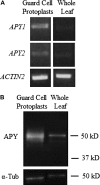
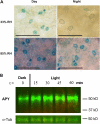
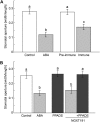
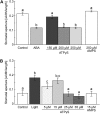
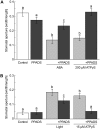
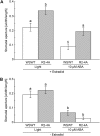
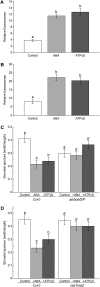



Similar articles
-
Effects of chemical inhibitors and apyrase enzyme further document a role for apyrases and extracellular ATP in the opening and closing of stomates in Arabidopsis.Plant Signal Behav. 2013 Nov;8(11):e26093. doi: 10.4161/psb.26093. Epub 2013 Aug 29. Plant Signal Behav. 2013. PMID: 23989340 Free PMC article.
-
Apyrase suppression raises extracellular ATP levels and induces gene expression and cell wall changes characteristic of stress responses.Plant Physiol. 2014 Apr;164(4):2054-67. doi: 10.1104/pp.113.233429. Epub 2014 Feb 18. Plant Physiol. 2014. PMID: 24550243 Free PMC article.
-
Role for apyrases in polar auxin transport in Arabidopsis.Plant Physiol. 2012 Dec;160(4):1985-95. doi: 10.1104/pp.112.202887. Epub 2012 Oct 15. Plant Physiol. 2012. PMID: 23071251 Free PMC article.
-
Breakthroughs spotlighting roles for extracellular nucleotides and apyrases in stress responses and growth and development.Plant Sci. 2014 Aug;225:107-16. doi: 10.1016/j.plantsci.2014.06.002. Epub 2014 Jun 11. Plant Sci. 2014. PMID: 25017166 Review.
-
Apyrases, extracellular ATP and the regulation of growth.Curr Opin Plant Biol. 2011 Dec;14(6):700-6. doi: 10.1016/j.pbi.2011.07.013. Epub 2011 Aug 19. Curr Opin Plant Biol. 2011. PMID: 21855397 Review.
Cited by
-
The biochemical properties of the Arabidopsis ecto-nucleoside triphosphate diphosphohydrolase AtAPY1 contradict a direct role in purinergic signaling.PLoS One. 2015 Mar 30;10(3):e0115832. doi: 10.1371/journal.pone.0115832. eCollection 2015. PLoS One. 2015. PMID: 25822168 Free PMC article.
-
New Insight into Plant Signaling: Extracellular ATP and Uncommon Nucleotides.Cells. 2020 Feb 2;9(2):345. doi: 10.3390/cells9020345. Cells. 2020. PMID: 32024306 Free PMC article. Review.
-
DORN1/P2K1 and purino-calcium signalling in plants: making waves with extracellular ATP.Ann Bot. 2020 Jan 6;124(7):1227-1242. doi: 10.1093/aob/mcz135. Ann Bot. 2020. PMID: 31904093 Free PMC article.
-
Populus euphratica Apyrases Increase Drought Tolerance by Modulating Stomatal Aperture in Arabidopsis.Int J Mol Sci. 2021 Sep 13;22(18):9892. doi: 10.3390/ijms22189892. Int J Mol Sci. 2021. PMID: 34576057 Free PMC article.
-
Small holes, big impact: Stomata in plant-pathogen-climate epic trifecta.Mol Plant. 2024 Jan 1;17(1):26-49. doi: 10.1016/j.molp.2023.11.011. Epub 2023 Dec 1. Mol Plant. 2024. PMID: 38041402 Free PMC article. Review.
References
-
- Barbour MM, Buckley TN. (2007) The stomatal response to evaporative demand persists at night in Ricinus communis plants with high nocturnal conductance. Plant Cell Environ 30: 711–721 - PubMed
-
- Bright J, Desikan R, Hancock JT, Weir IS, Neill SJ. (2006) ABA-induced NO generation and stomatal closure in Arabidopsis are dependent on H2O2 synthesis. Plant J 45: 113–122 - PubMed
-
- Burnstock G. (2008) Purinergic signalling and disorders of the central nervous system. Nat Rev Drug Discov 7: 575–590 - PubMed
-
- Clark G, Roux SJ. (2009) Extracellular nucleotides: ancient signaling molecules. Plant Sci 177: 239–244
Publication types
MeSH terms
Substances
LinkOut - more resources
Full Text Sources
Other Literature Sources
Molecular Biology Databases

